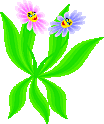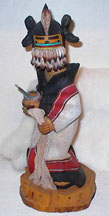Angiosperms

Angiosperms are also known as flowering plants.
Evolutionarily, they are more advanced than the older groups
which bear cones and spores in their "race to reproduce". Apparently
they are more sucessful too, as Angiosperms and especially Dicots,
vastly outnumber the other groups. [I could go on, but this is not
the time and place for Darwinian evo-babble]
If you are really into this, check out
National
Geographic July 2002, there is some really neat information
on the "oldest flowering plants" in that, as well as general taxonomy
on plant species. AND some great photography!!!
Many Orchids and Lilies (Monocots) are either very unpalatable, or
poison, and best left alone. They are rarely mentioned in Western
herbal lore, and seem to lurk around the edges of human interest.
(Even mushrooms rate more interest) Orchids often are parasites or
saprophytes, living off the good will of other species. However, many
are very pretty to look at, and very worth collecting if you love
beautiful things.
Another reason that we don't have much herbal lore on orchids in
North America is that most orchids are jungle and rain forest
residents. The indigenous jungle people in the USA (Southeast and
Florida) were pretty much "de Indianized" by 1812, and the
rainforests turned into farmland, so much of this lore (and probably
many orchid species) are lost forever. What we have left are orchids
in the Amazon and Central American rainforests, therefore not part of
this course. An herbal item that we frequently use from Orchids is
the vanilla bean.
Lily Family
|
Latin or Botanical name
|
common name
|
herbal or edible use
|
|
Calypso
bulbosa
|
Angel slipper
|
Calypso was a nymph that Odysseus cavorted with, so that
might help with remembering the name. Calypso means
"concealment"
|
|
Corallorhiza
maculata
|
Spotted Coral Root
|
If "immaculate" means "unspotted" then "maculate" means
"spotted" Lives in the roots of trees.
|
|
Goodyera
oblongifolia
|
Rattlesnake Plantain
|
Not a true plantain (they are dicots) There's a very cute
story about Native kids making balloons out of these leaves
in Polar and McKinnon. Any herbal use it has seems
associated with bleeding.
|
We didn't look at many Monocots in this class. The good news is
they are easy to identify. There are a few Monocots that are of such
use to us in our everyday lives, as food, that we cannot pass them
over.
Lily Family--Liliaceae--Onions,
garlic, leeks, chives and shallots all belong to this family. They
are noted for their enhancement of food, the "spice of life". They
are also indicated in folk lore as keeping colds away, and generally
strengthening the body. Wild onions are used in the tribal rituals of
the Muskogee people of Alabama.
|
Latin or Botanical name
|
common name
|
herbal or edible use
|
|
Camassia quamish
|
Camas bulb
|
Was semi-cultivated by the Pacific Northwest tribes.
Literature on camas bulbs is loaded with warnings about the
Death
Camas, a plant with similar bulb and leaves. The leaves
and bulbs of the Death Camas give burning sensation when
touched to the tongue. Flowers of the two plants are very
different, which just points up the lessons that we learned
in our class, that you really can't always identify plants
well, unless you have the bloom. The local natives took
great pains to harvest while the camas were in bloom, to
avoid such mix-ups, and they eradicated the Death Camas from
the real Camas beds at every opportunity. Lewis and Clark
found huge fields of camas when they first got here (like
oceans of blue), but of course, they have been crowed out by
urbanization, and a shift in the diets of indigenous groups.
Apparently camas make great eating, and are sweet, but
gassy!
|
|
Maianthemum
dilatatum
|
Wild Lily of the Valley (also Deer Berry, Snake Berry)
|
Various tribes ate the leaves raw as a "purgative" roots
and leaves both used as external washes and poltices, and
for eye treatments. Again, the berries are edible, but not
very.
|
|
Maianthemum
racemosa
|
Large False Solomon's Seal
|
I think this was the inflourescence with the wonderful
smell. Berries edible, not very good, root used as a
poltice. Roots boiled and drank by some Natives as
purgative.
|
|
Maianthemum
stellatum
|
Small False Solomon's Seal, Star flowered False Solomon's
Seal
|
Edible berries, but not very tasty.
|
|
Trillium ovatum
|
Wood Lily
|
I was delighted to find in Audubon's sketches, a cousin
to this, the Toad Shade, which is native to New England.
It's almost identical!
Trilliums have herbal properties, check it out!
|
Iris Family--there are wild iris in
the Pacific Northwest, but we didn't study any of them, and none have
herbal properties that I can find. But they are very pretty.
Crocus sativa is an Iris, and the source of saffron, but it's
introduced here. The native iris is much more slender and tougher in
blade, than the store bought "cultivar" iris, and the bloom is
smaller and more modest, as well.
Arum Family--Araceae
|
Latin name
|
common name
|
herbal use
|
|
Lysichiton
americanum
|
American Skunk Cabbage, Swamp Lantern
|
There is a very good article in the Seattle Times,
June 3, 2002 about this plant. Some fool was discussing
making a "tonic" drink from this plant. If anyone wants to
try it out, be my guest and let me know how it goes :P Only
bears appear to enjoy eating it raw. The local Natives had a
pretty good traditional story in the newspaper article
(involved salmon of course); the Skunk Cabbage is the first
thing to come up in the Spring, something you only eat if
you are starving. (The roots are edible, if cooked:
apparently the leaves will sting your tongue good!) Leaves
were used by Natives for wrapping food and lining baskets.
|
Grass Family--Corn, wheat,
rye.........so many of the grain plants come from the Grass Family.
Also grasses are very palatable to herbivores, so they are a useful
plant group indeed. Corn has major religious significance to most
Native American people, especially Gulf Basin and Northeastern
Tribes, and the Hopi.

[a Kachina of Corn Maiden, I think]
Cattails: Native Americans (and
early European settlers) used the fluff for bedding, and wove baskets
out of the long, strong leaves.
Duckweed--Lemna
minor--here in the Pacific northwest, the duckweed is maybe
1/8" in diameter. In Southern California, it's about 1/4" in
diameter. An odd plant, it just floats on top of still water. It has
little tiny roots that hang in the water sucking up nutrients, and it
practices photosynthesis (aka it's green). I'm sure water
critters eat it (fish and ducks), but otherwise it only has aesthetic
value for aquaculturalists.
Click here to go check out the rest of the
Angiosperms, the Dicots